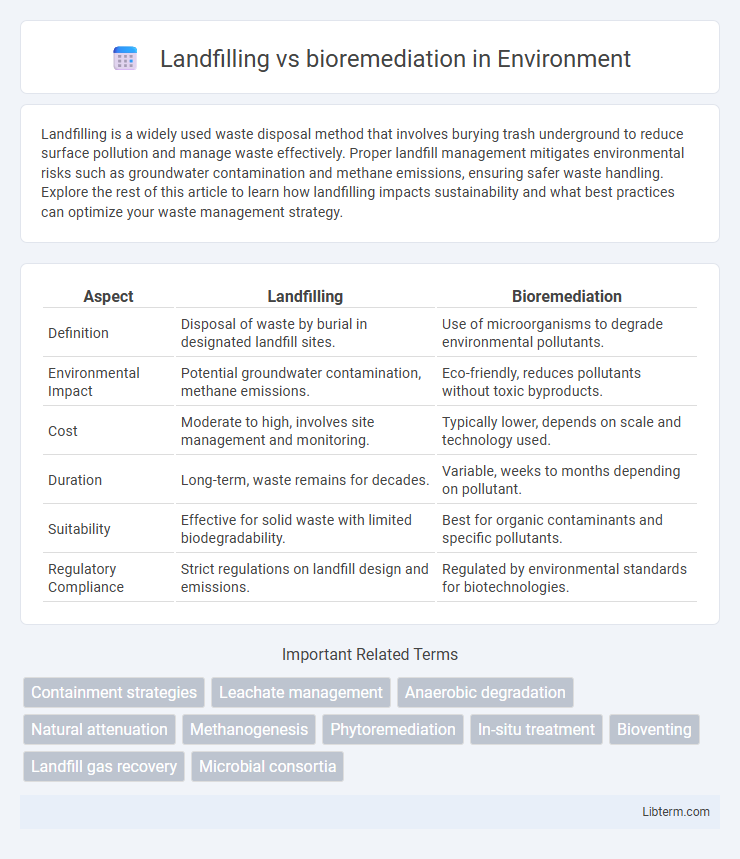Landfilling is a widely used waste disposal method that involves burying trash underground to reduce surface pollution and manage waste effectively. Proper landfill management mitigates environmental risks such as groundwater contamination and methane emissions, ensuring safer waste handling. Explore the rest of this article to learn how landfilling impacts sustainability and what best practices can optimize your waste management strategy.
Table of Comparison
| Aspect | Landfilling | Bioremediation |
|---|---|---|
| Definition | Disposal of waste by burial in designated landfill sites. | Use of microorganisms to degrade environmental pollutants. |
| Environmental Impact | Potential groundwater contamination, methane emissions. | Eco-friendly, reduces pollutants without toxic byproducts. |
| Cost | Moderate to high, involves site management and monitoring. | Typically lower, depends on scale and technology used. |
| Duration | Long-term, waste remains for decades. | Variable, weeks to months depending on pollutant. |
| Suitability | Effective for solid waste with limited biodegradability. | Best for organic contaminants and specific pollutants. |
| Regulatory Compliance | Strict regulations on landfill design and emissions. | Regulated by environmental standards for biotechnologies. |
Introduction to Landfilling and Bioremediation
Landfilling involves the burial of waste materials in designated sites, aiming to isolate contaminants from the environment through containment and capping techniques. Bioremediation employs microorganisms or plants to naturally degrade or transform hazardous pollutants into less harmful substances within soil or water ecosystems. Both methods address waste management and pollution control but differ fundamentally in approach, with landfilling serving as a containment strategy and bioremediation emphasizing ecological restoration and contaminant breakdown.
Environmental Impact Comparison
Landfilling generates long-term environmental challenges due to methane emissions, leachate production, and land use issues, contributing significantly to greenhouse gas effects and groundwater contamination. Bioremediation offers a sustainable alternative by utilizing microorganisms to naturally degrade hazardous contaminants, reducing soil and water pollution while minimizing ecological disruption. Although bioremediation may require longer remediation periods, its environmental footprint is considerably lower compared to conventional landfilling practices.
Economic Considerations
Landfilling generally involves lower initial capital costs but incurs long-term expenses due to maintenance, monitoring, and potential environmental liabilities. Bioremediation often requires higher upfront investment in technology and skilled labor but can reduce waste volume and recover valuable resources, leading to cost savings over time. Economic evaluations must consider site-specific factors, regulatory compliance, and potential benefits from enhanced environmental outcomes and resource recovery.
Land Use and Space Requirements
Landfilling requires extensive land area allocation, often leading to large, long-term plots that can consume valuable space and disrupt natural habitats. Bioremediation, by contrast, typically demands significantly less land since it treats contaminants in situ or at smaller, controlled sites, minimizing spatial impact. This reduced land use makes bioremediation a more sustainable option in areas with limited space or high environmental sensitivity.
Long-Term Sustainability
Landfilling offers a conventional waste disposal method but poses long-term environmental risks, including groundwater contamination and methane emissions. Bioremediation uses microbial processes to detoxify and degrade pollutants, promoting soil and water restoration while reducing ecological footprints. This method enhances long-term sustainability by transforming hazardous waste into non-toxic byproducts and supporting ecosystem recovery.
Pollutant Reduction Efficacy
Landfilling primarily isolates waste, often leading to the slow release of pollutants over time, whereas bioremediation actively degrades contaminants through microbial processes, significantly enhancing pollutant reduction efficacy. Studies show bioremediation can reduce organic pollutants by up to 90%, effectively transforming harmful compounds into non-toxic substances. In contrast, landfilling's pollutant containment depends on engineering controls, which may fail and result in groundwater contamination risks.
Regulatory and Legal Frameworks
Landfilling is regulated by strict environmental laws such as the Resource Conservation and Recovery Act (RCRA) in the United States, which mandates standards for waste containment, leachate management, and groundwater monitoring to prevent contamination. Bioremediation practices operate under frameworks like the Comprehensive Environmental Response, Compensation, and Liability Act (CERCLA) and state-specific environmental protection agencies, emphasizing site-specific cleanup criteria and monitoring to ensure pollutant degradation meets legal thresholds. Regulatory agencies prioritize permits and compliance inspections for both methods, with bioremediation often requiring thorough risk assessments and demonstration of remediation efficacy to meet closure standards.
Advancements in Bioremediation Technologies
Recent advancements in bioremediation technologies have significantly improved the efficiency of organic waste degradation compared to traditional landfilling methods. Techniques such as microbial fuel cells, bioaugmentation, and enzyme-enhanced bioremediation accelerate contaminant breakdown and reduce landfill dependency. These innovations not only minimize environmental impact but also promote sustainable waste management by converting pollutants into harmless byproducts.
Community Health and Safety Implications
Landfilling poses significant risks to community health through potential groundwater contamination, methane gas emissions, and pest infestations, which can lead to respiratory issues, waterborne diseases, and other health hazards. Bioremediation offers a safer alternative by using natural microbial processes to degrade pollutants, reducing toxic exposure and minimizing environmental impact in surrounding communities. Implementing bioremediation can enhance long-term community safety by lowering the risk of harmful leachates and airborne contaminants associated with traditional landfills.
Future Perspectives and Recommendations
Landfilling remains a prevalent waste management method but poses long-term environmental risks such as groundwater contamination and methane emissions, driving the need for sustainable alternatives like bioremediation. Advances in microbial technology and bioaugmentation are expected to enhance the efficiency of bioremediation, making it a promising solution for detoxifying hazardous contaminants and reducing landfill dependency. Integrating bioremediation techniques with strict regulatory frameworks and continuous monitoring will optimize waste treatment outcomes and promote a circular economy.
Landfilling Infographic

 libterm.com
libterm.com